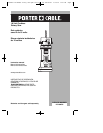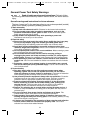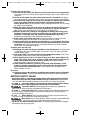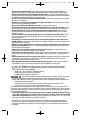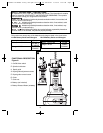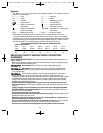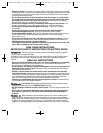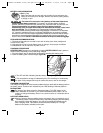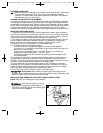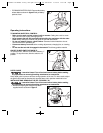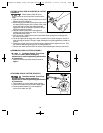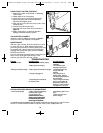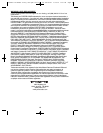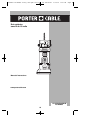
4
• Always wear eye protection. Dust mask and hearing protection must be used for
appropriate conditions. Using personal safety devices is recommended. WORK SAFE.
• Always operate the tool with the depth guide in place. The guide keeps the bit from
plunging too deeply through the material. A minimum of penetration should be maintained
to eliminate the danger of cutting into electric wiring.
• Do not use this tool with drill or screwdriver bits. This tool is not intended to be used
as a drill or screwdriver.
• Be sure your cutting bits are sharp and in good condition. Damaged bits can cause
the tool to jump, injuring the operator.
• Never touch the bit immediately after use. It may be extremely hot.
• Be sure that the motor has stopped completely before you lay the tool down. If the
cutter head is still spinning when the tool is laid down, it could cause injury or damage.
• Be sure that the bit is clear of the workpiece before starting motor. If the bit is in
contact with the workpiece when the motor starts it could make the tool jump, causing
damage or injury.
• If your tool fails to function properly, take it to an authorized service center. There
are no user serviceable parts inside this tool and it should only be opened by trained
service personnel.
• Use clamps or another practical way to secure and support the work piece to a
stable platform. Holding the work by hand or against your body leaves it unstable and
may lead to loss of control.
• When not in use, place tool on its side on a stable surface where it will not cause a
tripping or falling hazard. Some tools with large battery packs will stand upright but
may be easily knocked over.
• Keep your hair, clothing, and gloves away from air vents. Air vents often cover
moving parts in which these items can be caught.
• Hold tool firmly with two hands. Use auxiliary handle if provided. If auxiliary handle
not provided, grip tool at bottom of battery pack. Loss of control can cause personal
injury.
• Do not operate this tool for long periods of time. Vibration caused by tool action may
be harmful to your hands and arms. Use gloves to provide extra cushion and limit
exposure by taking frequent rest periods.
• Wear appropriate personal hearing protection during use. Under some conditions
and duration of use, noise from this product may contribute to hearing loss.
ALWAYS use safety glasses. Everyday eyeglasses are NOT safety
glasses. Also use face or dust mask if drilling operation is dusty. ALWAYS WEAR
CERTIFIED SAFETY EQUIPMENT:
• ANSI Z87.1 eye protection (CAN/CPA Z94.3),
• ANSI S12.6 (S3.19) hearing protection,
• NOSH/OSHA respiratory protection.
Some dust created by power sanding, sawing, grinding, drilling, and other
construction activities contains chemicals known to the state of California to cause
cancer, birth defects or other reproductive harm. Some examples of these chemicals are:
• lead from lead-based paints,
• crystalline silica from bricks and cement and other masonry products, and
• arsenic and chromium from chemically-treated lumber.
Your risk from these exposures varies, depending on how often you do this type of work.
To reduce your exposure to these chemicals: work in a well ventilated area, and work with
approved safety equipment, such as those dust masks that are specially designed to filter
out microscopic particles.
• Avoid prolonged contact with dust from power sanding, sawing, grinding, drilling,
and other construction activities. Wear protective clothing and wash exposed
areas with soap and water. Allowing dust to get into your mouth, eyes, or lay on the
skin may promote absorption of harmful chemicals.
Use of this tool can generate and/or disperse dust, which may cause
serious and permanent respiratory or other injury. Always use NOSH/OSHA approved
respiratory protection appropriate for the dust exposure. Direct particles away from face
and body.
:
:
:
90562807 PC1800SS rotary saw.qxd:??????-00 Cir Saw book 3/24/10 8:27 AM Page 4



